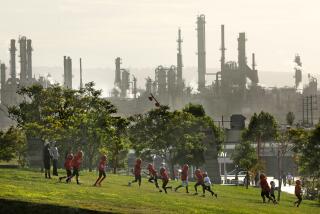Oil and Santa Monica Bay don’t mix
- Share via
For more than half a century, beachgoers have had their views of the Santa Monica Bay disturbed on a near-daily basis. What should be a pristine panorama of sky, sunlight and surf is interrupted by massive tankers unloading crude oil, which is then transported through a pipeline to the Chevron refinery in El Segundo. About 350 tankers each year offload more than 4 billion gallons of crude oil at the bay’s offshore mooring.
Now, Chevron’s lease on state lands that house the offshore marine oil terminal is up for renewal. On Friday, the State Lands Commission, composed of the governor, the lieutenant governor and the state controller, will vote on whether to certify an environmental impact report and approve a 30-year lease extension, as Chevron has requested.
The commission owes it to the people of California to carefully scrutinize the details of the lease and the environmental impact report.
The bay is a place of kelp forests, coastal wetlands, rocky intertidal areas and submarine canyons — delicate habitats that are particularly vulnerable to oil spills. It plays host to such sensitive species as endangered blue whales, brown pelicans and California least terns, and it sustains such incredible — and fragile — natural resources as the Ballona Wetlands and the kelp forests off the Palos Verdes Peninsula.
The threat of an oil spill is not just theoretical: In 1991 a tanker-caused pipeline rupture released 21,000 gallons of Chevron crude into Santa Monica Bay. Oil reached as far as the Malibu Lagoon, killing birds and fouling local beaches.
Chevron has operated a refinery in El Segundo since 1911, and the facility has grown and benefited greatly from the exclusive use of a marine terminal that sits only 1 1/2 miles from shore. The refinery will continue to operate regardless of Friday’s decision.
The state, on the other hand, has not reaped huge benefits from the arrangement. Chevron pays the state less than $1.3 million a year to use the Santa Monica Bay. That’s only about a penny a barrel to put precious marine and coastal resources, as well as lucrative beach tourism, at constant risk.
Personally, I’d like to see the tankers quit using the bay to unload their oil. But because that won’t happen anytime soon, the state should at least be properly compensated by Chevron.
California is in the worst economic crisis since the Depression, yet we are giving away our resources to the second-largest oil company in the world, with negligible financial benefit to the state. With so few available options for increased state revenue because of the passage of Proposition 26 — a campaign that received nearly $4 million in funding from Chevron — California should at least receive fair economic value for leasing its resources.
A far more sensible lease would be based on the oil volume piped in and out of the refinery through the marine terminal. The State Lands Commission should adjust the rent to something more like $1 a barrel, which would bring in more than $100 million in state revenue a year. That funding level could provide tremendous state lands protection and management at a time when there are scant general funds available for those crucial functions.
The commission should also look skeptically at the length of the lease. Chevron has requested a period of 30 years. Far more sensible would be a 10-year lease. The commission should also make it clear that during those 10 years, Chevron should study other options for offloading its tankers.
After 2013, the Chevron marine terminal will be the last and only nonfixed marine terminal operating in the state. Such terminals have successfully been removed from other places along the coast. So why would we want to give Chevron blanket permission to keep operating this one for 30 more years?
Unlike BP during the Deepwater Horizon disaster in the Gulf of Mexico, Chevron has an updated oil spill response program. However, the response time for a major event in Santa Monica Bay is far longer than for a spill in the ports of Long Beach and Los Angeles, which are far better equipped with skimmers, booms, fire boats and other heavy equipment.
It’s time to look at moving Chevron’s El Segundo offloading operation to the ports. Even as Chevron looks to extend its lease on the bay facility, Pier 400 at the Port of Los Angeles has an oil terminal looking for a major petroleum tenant.
On Friday, Gov. Arnold Schwarzenegger, Lt. Gov. Abel Maldonado and Controller John Chiang should consider what’s in the best interest of the environment and California taxpayers, not what best suits Big Oil.
Mark Gold is president of Heal the Bay.
More to Read
Sign up for Essential California
The most important California stories and recommendations in your inbox every morning.
You may occasionally receive promotional content from the Los Angeles Times.










